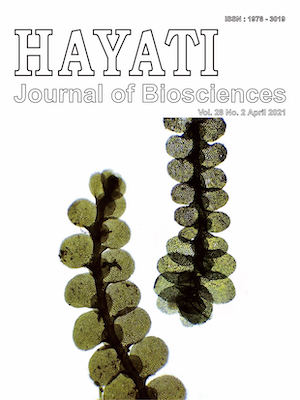Endophytic Fungi from Four Indonesian Medicinal Plants and Their Inhibitory Effect on Plant Pathogenic Fusarium oxysporum
Abstract
The medicinal plants Centella asiatica, Curcuma xanthorrhiza, Guazuma ulmifolia, and Hydrocotyle verticillata are widely used in Indonesian traditional medicine, but little is known about their associated endophytic fungi. This research aimed to study the diversity of endophytic fungi derived from functional parts of these plants and to evaluate their potential as antifungal agents against the plant pathogenic fungus Fusarium oxysporum. A total of 17 isolates of endophytic fungi were obtained: nine from leaves of G. ulmifolia, three each from leaves of C. asiatica and H. verticillata, and two from rhizomes of C. xanthorrhiza. The genus Colletotrichum was found in all plants studied, but each plant was associated with different species. Colletotrichum aeschynomenes was associated with C. xanthorrhiza, C. siamense was associated with C. asiatica, and C. tropicale was associated with G. ulmifolia and H. verticillata. The species Curvularia affinis, Diaporthe tectonae, Lasiodiplodia mahajangana, Parengyodontium album, Talaromyces trachyspermus, and Speiropsis pedatospora were found only in G. ulmifolia; while Didymella coffeae-arabicae and Muyocopron laterale were found only in H. verticillata. The endophytic fungi showed inhibition activity against F. oxysporum with inhibition values of 6.0-78.9%, T. trachyspermus JBd10 and C. affinis JBd14 gave the highest inhibition activity.
Downloads
HAYATI J Biosci is an open access journal and the article's license is CC-BY-NC. This license lets others distribute, remix, tweak, and build upon author's work, as long as they credit the original creation. Authors retain copyright and grant the journal/publisher non exclusive publishing rights with the work simultaneously licensed under a https://creativecommons.org/

























.png) IPB University
IPB University Department of Biology
Department of Biology The Indonesian Biological Society
The Indonesian Biological Society 

